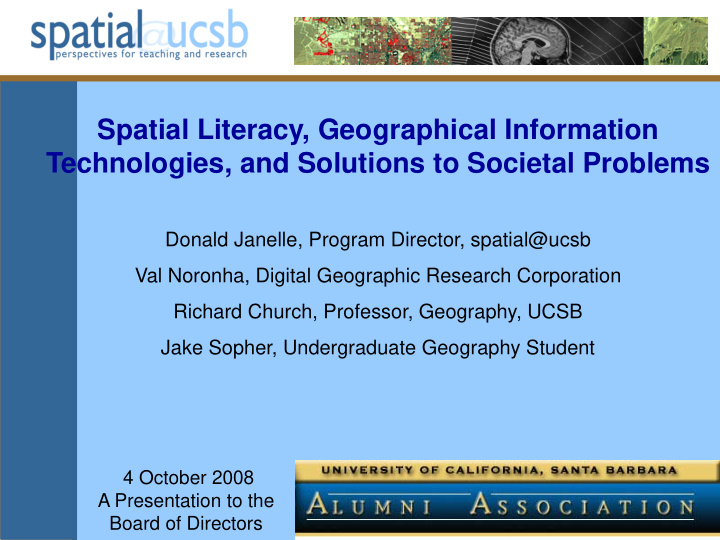



Spatial Literacy, Geographical Information Technologies, and Solutions to Societal Problems Donald Janelle, Program Director, spatial@ucsb Val Noronha, Digital Geographic Research Corporation Richard Church, Professor, Geography, UCSB Jake Sopher, Undergraduate Geography Student 4 October 2008 A Presentation to the Board of Directors
Spatial@ucsb Founded in 2007 as a center for spatial studies under the direction of Michael Goodchild Mission: to facilitate spatial thinking and use of spatial tools for learning, discovery, and problem solving in the natural, social, and behavioral sciences
Multiple Intelligences Howard Gardner, MIT seven types of intelligence Spatial Intelligence – “These children think in images and pictures. They may be fascinated with mazes or jigsaw puzzles, or spend free time drawing, building with Lego or daydreaming .” National Research Council report Learning to Think Spatially , 2006
Established 2007 to integrate a campus ‐ wide community of spatial thinkers CENTER FOR THE ANALYSIS OF SACRED SPACE The ALLOSPHERE Mike Goodchild, director of spatial@ucsb “ spatial@ucsb aims to change what people think of spatial thinking – from something that only experts need to know about, to something that everyone should use.” UCSB is Spatial
Applying Spatial Concepts and Geo-spatial Technologies – Maps – Geographic information systems (GIS) – Global positioning systems (GPS) – Satellite remote sensing – Environmental sensors that know where they are 5
London Cholera Epidemic,1854 ! Johnson, S. (2006) The Ghost Map. Riverhead Snow, J. (1949) Snow on Cholera. from Lance Waller, Emory University Oxford University Press.
Michael Gastner, Cosma Shalizi, and Mark Newman University of Michigan http://www- personal.umich.edu/~mejn/election/
Aerial Imagery / building footprints / hot spots / elevation data from LIDAR NYC Office of Emergency Management and NY Office of Cyber Security and Critical Infrastructure Coordination
Applying Spatial Technology to Solve Societal Problems • Congestion, Logistics, and Environmental Impacts of the Ports of LA / Long Beach ( Val Noronha ) • Emergency Preparedness: An example from Mission Canyon, Santa Barbara (Richard Church) • Gap Fire 2008 (Jake Sopher) • Spatial Literacy for 6 th graders
Congestion, Logistics, and Environmental Impacts of the Ports of LA / Long Beach ( Val Noronha ) DGRC-UCSB Partnership in Transportation • 1997: USDOT-Caltrans, SAE standards • 2000: USDOT: 4 national consortia, remote sensing • 2007: USDOT: 7 national consortia, remote sensing/GPS
Indio 10 Victorville Colton 15 Image: Google Earth Wilmington 40% 5
Facts • Big and growing – World’s largest port outside China- Singapore – 40% of U.S. import containers – 3x NY-NJ – 5x growth since 1990 – 3x more growth by 2030 • Drayage trucking is critical link – Freeways were designed for 1970s freight volumes – Owner-operators, make $10/hr net – No fleet optimization – Port operations: 50% of LA emissions
Important Questions • Before investing in new infrastructure: – Freight freeways, maglev … need to know where the goods go. When? Congestion times? Terminal gate delays? • Operational improvements: – Unproductive trips (empty containers, bobtails) – Terminals synchronize with truck arrivals?
Solutions • Live data – Comprehensive urban dynamics • Modeling – Infrastructure decisions – Operational efficiency • Stakeholders – Caltrans, LA DOT, SCAG – Terminal operators: APL (partner) – Trucking companies: TE (partner) – Commercialization consultants • Target: 10% reduction in port area freight traffic
Supplements Caltrans loop data
28% 6% 25% 4% 33% I-105 Meso Dynamics (710 N) Long Beach Blvd SR-91 2% Del Amo I-405 Willow PCH 100%
Micro Analysis • Truck detours: incursions on non-designated streets – Insufficient turn radii – Break median dividers, light poles – Traffic signal timing • Parking in residential neighborhoods
Fire Hazard & Evacuation Mission Canyon Santa Barbara Based on research by Richard Church (UCSB)
Simulations 1.8 vehicles per driveway Driver behavior influenced by: lane width slope 2D clip view distances traffic control mechanisms information feedback 3D clip driver aggressiveness 770 homes clearing times > 30 minutes
Gap Fire •Started 1 July 08 •Contained 28 July •Burned 9,443 a. •Power outages >150,000 homes •>2,500 fighters •>3,200 homes threatened •>5,000 people evacuated Map from Santa Barbara News Press
Map of the Recent Gap Fire � Further analysis will be performed on map � Map was created to have a record/archive of Gap Fire � Focusing on fire behavior and emergency response � Current map shows interaction of power lines and fire http://www.geogjake.tk Based on work of Jake Sopher on behalf of spatial@ucsb, 2008
Emergency Preparedness for Santa Barbara spatial@ucsb proposal to engage community and researchers to build prototype geo-information and communication system for emergencies • Santa Barbara—good case for proof of concept – isolated by physical geography – limited transportation accessibility – Diverse range of potential hazards – UCSB—leader in geo-spatial technologies • System to serve: – responders & strategic planners – citizens
•National Research Council Report, 2007 •Michael Goodchild, Chair of the NRC Committee on Planning for Catastrophe •Available at www.nap.edu
Promoting Spatial Literacy in Education • Identify spatial concepts basic for human well- being and for every-day life decisions • Introduce geographic tools to access data, analyze patterns and processes, and solve problems • Develop curricula resources for school teachers and for undergraduate instructors/students • Create Web resources for teachers and learners
29 Nurturing the Next Generation of Spatial Thinkers
Thank You Questions? For more information on applications of spatial thinking in science and society www.spatial.ucsb.edu
Recommend
More recommend